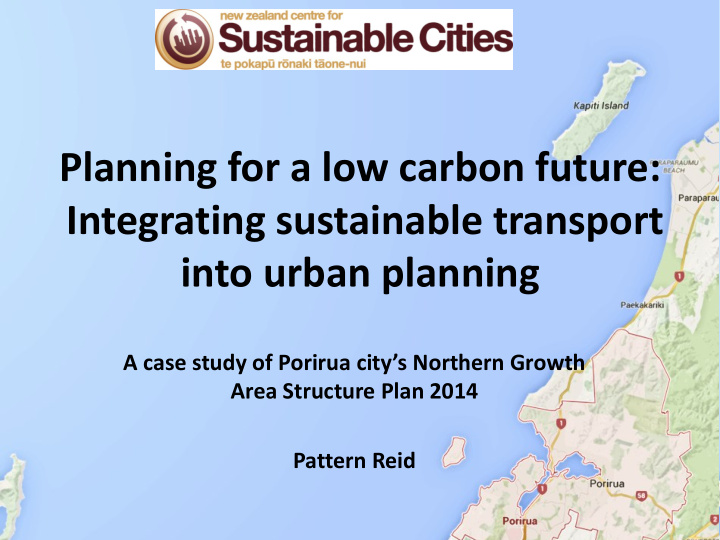



Planning for a low carbon future: Integrating sustainable transport into urban planning A case study of Porirua city’s Northern Growth Area Structure Plan 2014 Pattern Reid
Context • Climate change – Urban areas emit ~70% of energy related GHGs globally – large proportion attributable to car dependent transport • Hence carbon benefits of compact urban form • Co-benefits of sustainable urban design (e.g. access; land consumption; active travel) (New Climate Economy Report 2014)
The 5Ds: key features of a sustainable urban layout • density • diverse land uses • destination accessibility • design • distance to public transport. (Ewing et al. 2005)
Strategic spatial planning • Proactive vs reactive planning approach – long term thinking > 30 years – Holistic, integrated – Urban form blueprints • Provides a unique opportunity to – Plan transport alongside land use – Consider alternative approaches to urban form
Key question: • How well are features of urban form that induce more sustainable transport outcomes being incorporated into strategic urban planning?
Porirua: A case study • A satellite town for Wellington City, a key node in the regional transport network • Existing urban form is low density, and car orientated • Drivers for new development: population growth, housing prices
Northern Growth Area Structure Plan • Planning context • Strategic planning aimed to ensure ‘sustainable, coordinated and integrated urban and rural development’ • Multi criteria assessment of development options • Existing opportunities for more sustainable urban form
Development scenarios No density suggested Rural residential Standard residential Standard residential Low density Med. residential density density density residential density 0.35 dwellings/ha 10 dwellings/ha 10 dwellings/ha 6 dwellings/ha 40 dwellings/ha - ( Figure adapted from Boffa Miskell. 2014. Porirua Northern Growth Area Structure Plan: Technical Report prepared by Boffa Miskell Ltd and Aurecon Ltd for Porirua City Council July 2014 .)
Why wasn’t scenario 5 chosen? • Planning objectives • Limitations of a comparative methodology – Only one option with credible medium density • Perceptions of density • Roading capacity • Development uncertainty • Returns on investment
Conclusion • Missed opportunity in Porirua for a more environmentally sustainable urban form • Framing of options tended to reflect status quo & public resistance to medium density housing • Under RMA, presumption of permissiveness, and limited ability of local govt to direct development to prioritise sustainability • Difficult to reshape conventional thinking about the shape of cities (including options for more sustainable transport )
Recommend
More recommend